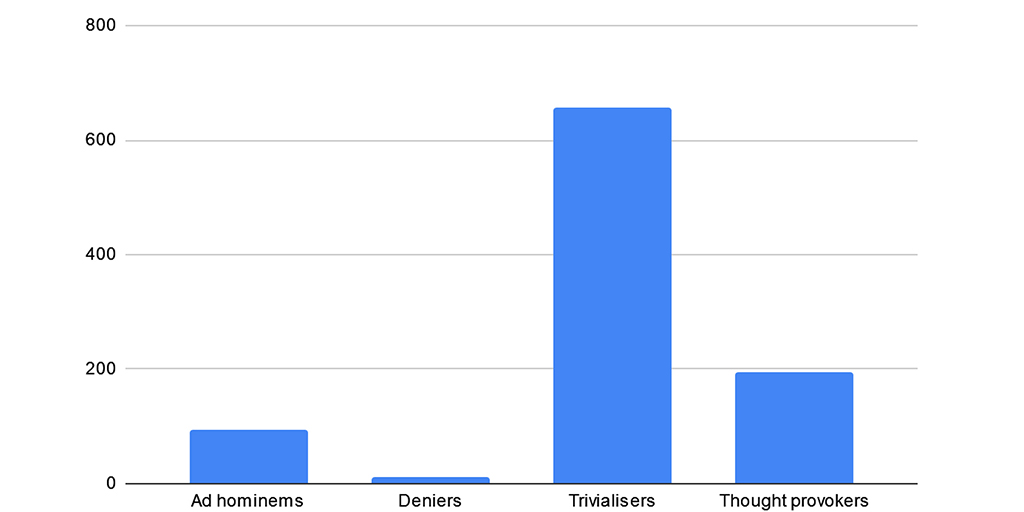
Why (not) so serious? Anne Frank memes and digital Holocaust memory
In this month’s guest blog, Juan Manuel González Aguilar and Mykola Makhortykh offer an analysis of the different types of Anne Frank memes circulating online.
Please be advised that this blog includes images that are offensive. They are included here for their importance in increasing public understanding of online Holocaust denial, distortion and trivialisation.
The rise of online participatory culture has brought about significant changes in how individuals and societies engage with the past. By facilitating the creation and dissemination of content generated by ordinary users, this participatory turn enables more diverse and less top-down ways of representing and interpreting historical events (Jones and Gibson 2012). However, the long-term effects of this transformation are yet unclear: while the importance of establishing more pluralistic memory practices can hardly be questioned, the digital-driven democratization of remembrance does not always deliver the expected results.
Internet Memes
Internet memes are
units of popular culture that are circulated, imitated, and transformed by individual Internet users, creating a shared cultural experience.
Usually, memes take the form of an image accompanied by a (relatively) short piece of text that extends and offers interpretation of the visual part of the meme, often with the purpose of making a joke or otherwise entertaining the audience. To achieve this aim, memes commonly reiterate – and often remix – existing elements of popular culture, such as scenes from blockbusters (Figure 1a) or song quotes (Figure 1b).
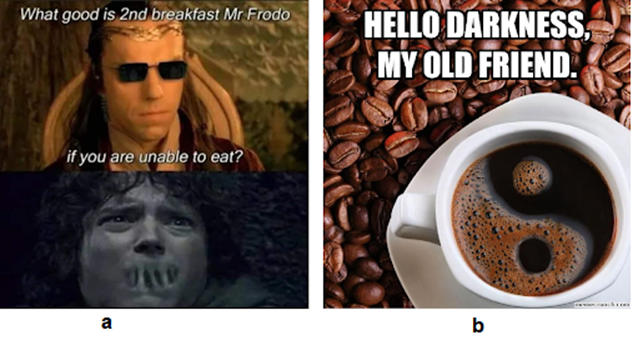
Figure 1. Examples of popular memes
Originally popularized by Richard Dawkins (1976) in the 1970s, who treated memes as viral cultural units which ranged from catchphrases to religions, the concept of a meme experienced a comeback both in scholarship and everyday online communication following the rise of Web 2.0. This timing can be attributed to technological advancements, in particular the wide accessibility of tools for creating and editing digital content as well as the very nature of networked cultures that encourage creative adaptation and sharing. Under these circumstances, memes with their ability to endlessly re-appropriate new cultural products and quickly spread across the Internet became an epitome of “vibrant remix culture” (Xu et al., 2016).
Besides their adaptability and virality, the popularity of memes can be attributed to their strong affective potential which facilitates the use of memes not only for entertainment, but also for social commentary on matters ranging from climate change (Zhang and Pinto 2021) to remembrance of traumatic pasts (Khoruzhenko 2020) as Figures 2a and 2b show. However, the fact that this potential is often driven by humour creates a dilemma concerning the appropriateness of using memes for engaging with memory, in particular when it relates to the Holocaust.
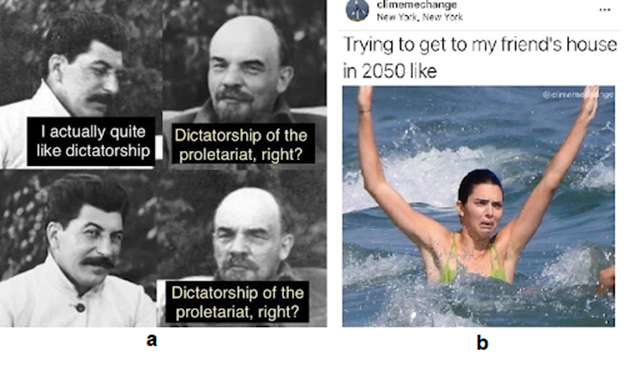
Figure 2. Memes related to climate change and atrocities’ memory
Mediations of Anne
While existing studies on Holocaust humour (see, for instance, Steir-Livny 2017; Demsky 2021) demonstrate that this dilemma is not totally new, the popularity of memes amplifies its importance in the context of the ongoing debate on the long-term impacts of digital technology on Holocaust remembrance (Makhortykh 2019; Walden 2015). To address it, we look at Internet memes devoted to Anne Frank, an iconic Holocaust victim. Frank’s story became widely known after the publication of the diary that she kept while staying in hiding during Nazi occupation of the Netherlands. The popularity of the diary together with extensive mediatization of Frank’s memory in formats ranging from theatre plays to animated series contributed to the “canonization” of Frank as both an archetypical Holocaust victim and, perhaps most problematically, a universal symbol of hope. Whilst the diary ends on a sentimental tone, Anne died at Bergen-Belsen a few days before liberation.
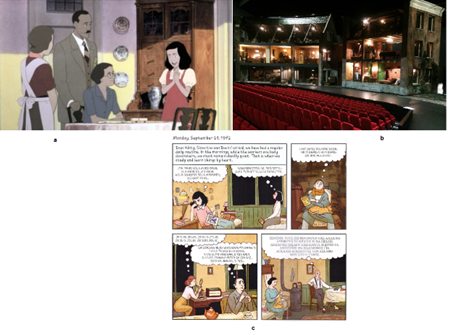
Figure 3. Mediations of Anne Frank memory: (a) Anne no nikki anime (b), Anne theatre play (both from Wiki Commons), and (c) Anne Frank’s Diary graphic novel © Images are included here under fair use policy.
One of the consequences of the unique status of Anne Frank is the growing volume of online content devoted to her memory. While much of this content comes from mainstream memory institutions (e.g., Anne Frank House), Frank’s memory is increasingly mediated through user-generated content. Considering the importance of memes as a form of user-generated content that makes the process of remediating the past viral (Makhortykh and Aguilar 2020), we aim to understand what happens with memory about this iconic Holocaust personality when it becomes a subject of internet memes.
Analysing Memes
To conduct our analysis, we searched for Anne Frank memes on seven of the world’s largest search engines:
- DuckDuckGo
- Bing
- Yahoo
- Yandex
- Ecosia
- Baidu
For each search engine, we used the queries “Anne Frank meme” and “Anne Frank holocaust meme” and extracted the top 20 results. We repeated the searches twice, on February 26 and March 5, 2021, and did it simultaneously from our places of residence, Switzerland and Spain, using clean browsers to minimize potential effects of personalization. The resulting dataset consists of 1,115 images, the majority of which are internet memes (a major exception is Baidu, a Chinese search engine, where most of the outputs are not memes, but images of Frank-related commercial products and exhibitions).
After collecting the images, we used a combination of content analysis and close reading to analyse the memes. Specifically, we examined each image to identify whether it is actually an internet meme. For this project, we defined memes as images containing both a visual and a textual component which were merged together – or remixed – to create a new digital culture unit. It meant that, for instance, we did not treat as memes historical photos of Anne Frank which did not experience any additional changes. The same was true for the non-modified images of the Anne Frank diary: while such photos often included both visual and textual elements, these components were not remixed and, thus, did not constitute a meme.
Out of 1,115 images collected, 924 (approximately 83%) turned out to be memes according to our definition. These 924 images were the ones used for the remaining analysis, where we specifically looked at whether memes contain specific features, such as jokes, denialist statements, offensive claims, or humanistic messages. Then, we grouped these features together to identify four main classes of Anne Frank memes which we discuss in more detail below.
1. Ad hominems
The first class of memes we identified is ad hominems which attack different aspects of Frank’s identity, in particular her Jewishness and womanhood. While such memes are relatively infrequent, their messages tend to be particularly offensive towards Frank’s memory. The antisemitic ad hominems utilise racist (and often dehumanising) statements that present Frank (and Jewish victims in general) in reference to mental illness or as an animal. The latter case is exemplified by a meme remixing a scene from one of the episodes of the SpongeBob SquarePants series (Figure 4b). The scene shows a protagonist, SpongeBob (presented as Hitler), catching one of the series’ recurring antagonists, Bubble Bass (presented as a Jew), when stealing the pickles (Anne Frank’s image). Not only does the meme dehuminise Holocaust victims using an image of a frog, but also stigmatises them as thieves trying to monopolise Frank’s memory.
By contrast, misogynistic memes usually rely on sexualisation of Frank’s images that downplays the importance of memory about her which is treated as a means of satisfying the sexual desires of the viewer. In some cases (see Figure 4a), such expressions of misogyny are closely intertwined with antisemitic connotations ranging from explicit references to Jewishness (e.g., “jew ears” treated as a disadvantage) to revocations of stereotypes of Jewish women being imagined as witches (e.g., “crooked teeth”) that can be traced back to the medieval times (Climenhaga 2012).
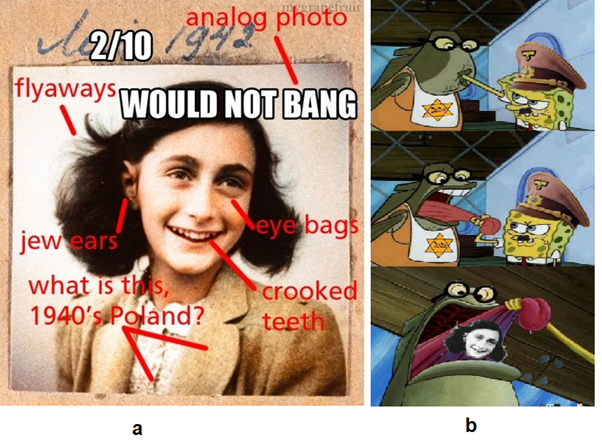
Figure 4. Ad hominem memes
2. Denial
Deniers, who repudiate that the Holocaust happened, constitute another rare class of Anne Frank memes. While the use of the iconic victim’s image for denying the Holocaust might look counter-intuitive, Frank’s memory was targeted by Holocaust denialists way before the digital era (Sion 2012). In both cases, the authenticity of Frank’s diary is the main target of denialism with memes utilising humour to question the validity of photos of Frank (Figure 5a) or to challenge the existing narrative about her life (Figure 5b). The latter example, which ‘creatively’ appropriates a racial justice argument for promoting Holocaust denialism, is particularly concerning as it highlights the possibility of hijacking the latest societal developments and online reactions to them for propagating distortions of historical facts.
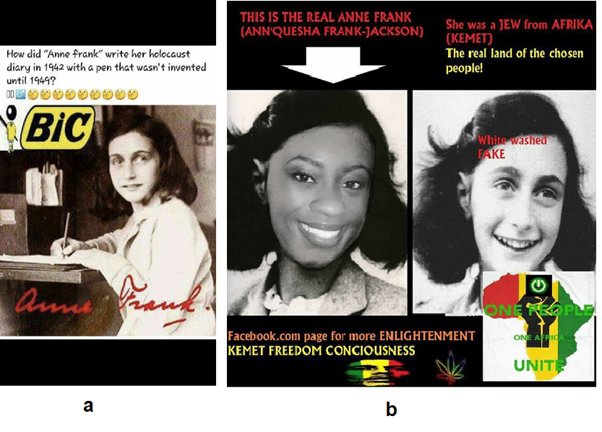
Figure 5. Denier memes
3. Trivalisers
The third and the most numerous class is trivialisers who appropriate memory about the Holocaust for entertainment purposes. There are several ways in which such appropriation happens in the case of Anne Frank. Some memes rely on cynical claims about Frank’s suffering, be it her death in the concentration camp or the need to stay in hiding. Often, such memes generalise Frank’s memory to comment on Holocaust victims in general (similar to ad hominems) and add new elements to her story, including the ones which have little relation to the facts (e.g., memes claiming that Frank was posthumously turned into a piece of soap; Figure 6a). Other trivialisers rely on the play of words, such as the ambiguous meaning of words “baked” or “gas” (Figure 6b) to achieve humoristic effect.
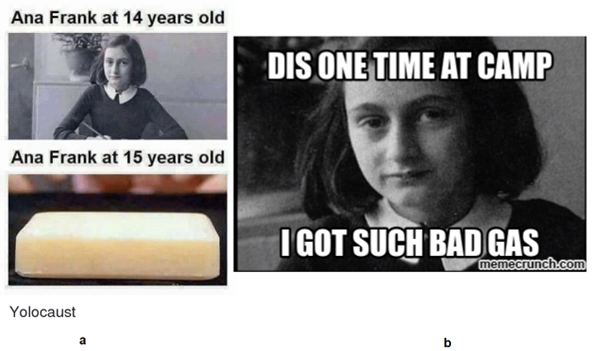
Figure 6. Trivialiser memes
4. Thought provokers
Thought provokers is the last class of memes which uses Frank’s memory as a form of social commentary. Often, such commentary is used to reinforce existing Holocaust memory practices by reiterating the image of Frank both as an iconic Holocaust victim and as a symbol of hope and resilience. Such an effect is usually achieved by reproducing well-known quotes from the diary coupled together with Frank’s image (Figure 7b). In other cases, however, memes refer to Frank’s memory to comment on matters not directly related to the Holocaust, such as anti-migration policies or COVID-19 quarantine measures (Figure 7a).
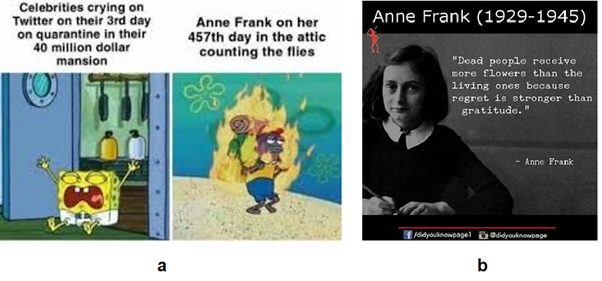
Figure 7. Thought provoker memes
Conclusions
So, what do these observations tell us about the impact of internet memes on Anne Frank memory? First, many memes (similar to other forms of user-generated content) conflict with mainstream memory practices by making fun of the past suffering. While in some cases, such meme-driven trivialisation can be viewed as a means of resisting appropriation of the past by institutions or states (Steir-Livny 2016), in others such conflicts can facilitate promotion of denialism as well as antisemitic and misogynistic views masked as online jokes. At the same time, the function of memes is not limited to trivialisation of the past, indeed some examples reiterate prevalent practices of Holocaust remembrance by reinforcing the iconic status of Anne Frank and appropriating it to new contexts.
In terms of numbers of memes of a specific class (Figure 8), out of the 924 memes we analysed, trivialisers turned out to be the most common followed by thought provokers. The more obnoxious classes, namely ad hominems and denies, constitute a minority that can be attributed both to the effort of search engines to filter out offensive pieces of user-generated content and difficulties of formulating a coherent argument in the format of a meme which might be the case with deniers.
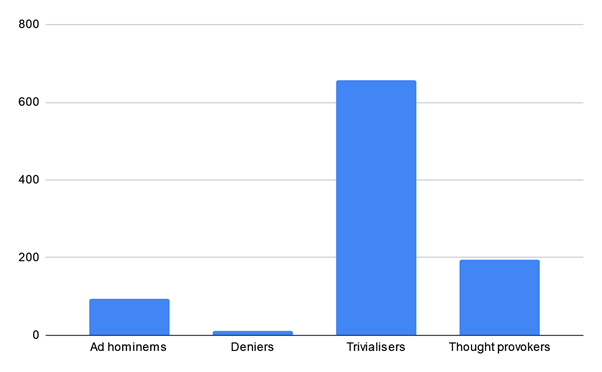
Figure 8. Distribution of memes by type. Because some memes could belong to several classes, the number of memes of different classes combined is larger than 924 (i.e., the total set).
Second, independently of whether they are serious or not about the past, memes tend to assume that their audience is familiar with it. Because of this assumption, they tend to focus on often isolated aspects of Frank’s memory, be it factual or fictional ones, such as optimism expressed in the diary or the incorrect idea that she was murdered in the gas chambers (another fictional trope that is commonly promoted by memes). It leads to the hyperselective logic of interacting with the past through memes that can on the one hand stimulate interest towards investigating the past, but on the other hand can further fragment its perceptions.
Altogether, our findings reiterate the importance of recognising a nuanced relationship between user-generated content and remembrance of past suffering, including the Holocaust. While undoubtedly promising and important for preserving the memory of the victims for many decades to come, the relationship between memes and memory is rather ambiguous and cannot be treated as exclusively a positive or negative phenomenon. Understanding the effects of this ambiguity that is enabled both by new technological affordances and the new cultural practices evolving around these affordances is essential for understanding the future of digital Holocaust memory.
 Mykola Makhortykh is a postdoctoral researcher at the University of Bern, where he studies information behavior in online environments. Before moving to Bern, Mykola defended his PhD dissertation at the University of Amsterdam on the relationship between digital platforms and WWII remembrance in Eastern Europe and worked as a postdoctoral researcher in Data Science at the Amsterdam School of Communication Research, where he investigated the effects of algorithmic biases on information consumption. His other interests involve interactions between cybersecurity and cultural heritage, digital war remembrance and critical algorithmic studies. Recently, Mykola published in First Monday on biases in algorithmic curation of Holocaust-related content, in Digital Journalism on filter bubbles in non-Western media ecosystems, and in Memory Studies on remediation of WWII memorJuan Manuel González-Aguilar is a predoctoral fellow at the Universidad Internacional de La Rioja (UNIR), Spain. He is working on his PhD dissertation in television studies, specifically on analyzing the programming of contemporary private channels. Before starting his PhD, Juan Manuel completed a master’s degree in Audiovisual Heritage at the Universidad Complutense de Madrid, Spain. In recent years, he has developed other research lines focused on analyzing populism, the creation of collective identities, and hate speech in social networks. His interests have also focused on the treatment of historical memory in digital platforms. He is currently part of a UNIR project funded by the Spanish government, which focuses on analyzing hate speech in social networks. His work has been published in journals such as Continuum: Journal of Media & Cultural Studies, Estudios Sobre el Mensaje Periodístico, and Historia y Comunicación Social. y via digital platforms.
Mykola Makhortykh is a postdoctoral researcher at the University of Bern, where he studies information behavior in online environments. Before moving to Bern, Mykola defended his PhD dissertation at the University of Amsterdam on the relationship between digital platforms and WWII remembrance in Eastern Europe and worked as a postdoctoral researcher in Data Science at the Amsterdam School of Communication Research, where he investigated the effects of algorithmic biases on information consumption. His other interests involve interactions between cybersecurity and cultural heritage, digital war remembrance and critical algorithmic studies. Recently, Mykola published in First Monday on biases in algorithmic curation of Holocaust-related content, in Digital Journalism on filter bubbles in non-Western media ecosystems, and in Memory Studies on remediation of WWII memorJuan Manuel González-Aguilar is a predoctoral fellow at the Universidad Internacional de La Rioja (UNIR), Spain. He is working on his PhD dissertation in television studies, specifically on analyzing the programming of contemporary private channels. Before starting his PhD, Juan Manuel completed a master’s degree in Audiovisual Heritage at the Universidad Complutense de Madrid, Spain. In recent years, he has developed other research lines focused on analyzing populism, the creation of collective identities, and hate speech in social networks. His interests have also focused on the treatment of historical memory in digital platforms. He is currently part of a UNIR project funded by the Spanish government, which focuses on analyzing hate speech in social networks. His work has been published in journals such as Continuum: Journal of Media & Cultural Studies, Estudios Sobre el Mensaje Periodístico, and Historia y Comunicación Social. y via digital platforms.
 Juan Manuel González-Aguilar is a predoctoral fellow at the Universidad Internacional de La Rioja (UNIR), Spain. He is working on his PhD dissertation in television studies, specifically on analyzing the programming of contemporary private channels. Before starting his PhD, Juan Manuel completed a master’s degree in Audiovisual Heritage at the Universidad Complutense de Madrid, Spain. In recent years, he has developed other research lines focused on analyzing populism, the creation of collective identities, and hate speech in social networks. His interests have also focused on the treatment of historical memory in digital platforms. He is currently part of a UNIR project funded by the Spanish government, which focuses on analyzing hate speech in social networks. His work has been published in journals such as Continuum: Journal of Media & Cultural Studies, Estudios Sobre el Mensaje Periodístico, and Historia y Comunicación Social.
Juan Manuel González-Aguilar is a predoctoral fellow at the Universidad Internacional de La Rioja (UNIR), Spain. He is working on his PhD dissertation in television studies, specifically on analyzing the programming of contemporary private channels. Before starting his PhD, Juan Manuel completed a master’s degree in Audiovisual Heritage at the Universidad Complutense de Madrid, Spain. In recent years, he has developed other research lines focused on analyzing populism, the creation of collective identities, and hate speech in social networks. His interests have also focused on the treatment of historical memory in digital platforms. He is currently part of a UNIR project funded by the Spanish government, which focuses on analyzing hate speech in social networks. His work has been published in journals such as Continuum: Journal of Media & Cultural Studies, Estudios Sobre el Mensaje Periodístico, and Historia y Comunicación Social.